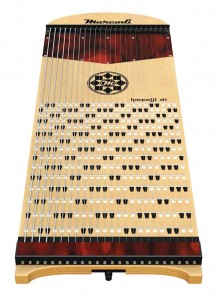 Piano instinct. Guitar soul. This is how the makers of theHarpejji describe it. The result of a piano student getting frustrated with the limitations that the instrument presented when compared to a guitar, the first working prototype of harpejji was completed in 2003. In 2008 a model was given to a man with a bent for such innovative instruments, Dream Theater’s Jordan Rudess and he has been using the instrument since then in his concerts. It won’t be long before Indians get exposed to more of the harpejji, as a few days back the maker personally delivered one to another person who is heavily into such new age instruments, A R Rahman.
Piano instinct. Guitar soul. This is how the makers of theHarpejji describe it. The result of a piano student getting frustrated with the limitations that the instrument presented when compared to a guitar, the first working prototype of harpejji was completed in 2003. In 2008 a model was given to a man with a bent for such innovative instruments, Dream Theater’s Jordan Rudess and he has been using the instrument since then in his concerts. It won’t be long before Indians get exposed to more of the harpejji, as a few days back the maker personally delivered one to another person who is heavily into such new age instruments, A R Rahman.For Timothy Meek, development of harpejji was a long-drawn evolutionary process. Starting to play keyboards in 1987, his search for an instrument that would negate the limitations of the keyboard led him to the Chapman Stick, a string-tapping instrument developed by Emmett Chapman in the 70s. Purchasing the Stick in 1998 Meek found that the Stick did address the problems he faced with the keyboard, but had a few problems of its own. Next stop was Dr. John Starrett of University of Colorado, Denver, who had invented and patented something called a Starrboard which was conceptually closer to what Meek had in mind. Getting a prototype from Dr. Starrett, Meek set about working on it, ironing out the rough edges until he had a satisfactory working model towards the end of 2003. Further improvements, and four years later, Meek incorporatedMarcodi Musical Products LLC with his musician friend Jason Melani to market the instrument he christened harpejji, after arpeggio which in Italian means harp-like.
At first glance the harpejji would come across as an oversized surfboard. With 24 strings, the instrument allows playing new chord intervals that are impossible to cover on a guitar or a piano. While a pianist would find the ability to produce organic sounds and expressions of real strings and double the octave range endearing, guitarists would be impressed by the increased flexibility provided in compositions by the ability to use all 10 digits, and the facility to cover guitar and bass portions simultaneously.
You can buy or get more details about the instrument here. Looking forward to more of harpejji in days to come.





No comments:
Post a Comment